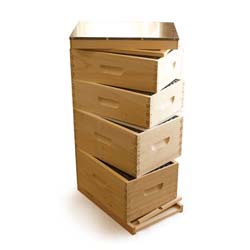If you’re a first-year beekeeper – or if your hive hasn’t yet made it through a winter – it’s best not to harvest honey this year. Your bees need that honey to survive their first winter. During their first year, honey bees invest most of their energy into building the wax comb that forms the structure of the hive. This process requires large amounts of nectar, which means fewer resources are available for storing surplus honey. Once your colony has successfully overwintered and proven it can sustain itself, then you can think about taking a surplus for yourself.
If this is your first time harvesting honey, it can feel overwhelming trying to figure out when it’s “ready.” The right timing depends on your bees’ progress, local weather, and nectar availability.
Most beekeepers do one main harvest each year, usually in late summer or early fall, after the main nectar flow has ended and the bees have capped most of their honey. Some beekeepers harvest smaller amounts at different times of the season to capture different floral flavors, but one harvest a year is the most common approach for beginners.
Here are the key things to look for when deciding if your honey is ready:
Season and Nectar Flow
The strength of your spring and summer nectar flow makes a big difference. A long dry spell or too much rain can reduce nectar availability and slow down honey production. Pay attention to local bloom cycles – if flowers are still blooming heavily, your bees may still be filling frames. Once blooms fade and nectar slows, your bees will start capping the honey they’ve already stored.
Capped Honey Percentage
This is the most important factor in deciding whether your honey is ready. Bees cap honey with wax once it has been dried to the right moisture level (around 16.5–18%). If you harvest before it’s capped, the honey can ferment.
Only extract honey that is at least 70–80% capped. A good check is to pull a frame and gently shake it horizontally – if uncapped nectar drips out, it’s not ready yet.
Is It Worth Harvesting?
If your hive only has one or two frames of capped honey, you’ll need to decide if it’s worth the effort to extract. Some beekeepers still enjoy taking a small batch their first time, even if it’s just a few jars. Others prefer to leave all the honey to the bees to strengthen the colony for winter. There’s no wrong answer – it depends on your goals and the health of your hives.
Local Timing
Check with your local beekeeping association or nearby beekeepers to learn when others in your area typically harvest. This varies by region and year, but local experience is a great guide. Use it as a reference point, not a strict rule – your hive’s readiness may differ depending on its strength and the forage available.
Leave Enough for the Bees
Never take more honey than your colony can afford to lose. Bees rely on those stores to survive winter when no nectar is available.
How much they need depends on your climate, size of the colony, types of bees (some are more frugal than others) and types of hives and insulation.
- Warm climates: around 40–60 pounds (roughly one deep box of honey)
- Cold climates: 80–100 pounds (often two deep boxes)
- Note that these are general recommendations, but you should always consider all of the factors of your hive since there’s no cookie cutter situation and solution in beekeeping.
Depending on the size of your colony going into winter, smaller colonies (about 6–10 frames of bees) may require less stored honey – typically around 30–50 pounds – even in colder climates. Regardless of how much you leave, it’s important to check their food stores mid-winter, usually in January. If resources are running low, you can provide emergency feed such as fondant (preferred), sugar cakes, dry sugar, or a candy board – anything to prevent starvation. When in doubt, err on the side of leaving more honey, especially if your hive is small or newly established.
